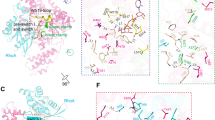Abstract
Toxin A and toxin B from Clostridium difficile are the causative agents of the antibiotic-associated pseudomembranous colitis. They are of an A/B structure type and possess inositol hexakisphosphate-inducible autoproteolytic activity to release their glucosyltransferase domain to the cytoplasm of target cells. In this study, we investigated the effect of extracellular and intracellular autoproteolytic cleavage on the function of TcdA. Extracellular cleavage led to functional inactivation albeit TcdA was less susceptible to inositol hexakisphosphate-induced autoproteolysis than TcdB. A non-cleavable TcdA mutant (TcdA A541 G542 A543) was generated to investigate whether autoproteolysis is a prerequisite for intracellular function of TcdA. Although the EC50 regarding cell rounding was about 75-fold reduced in short-term assay, non-cleavable TcdA was able to induce complete cell rounding and apoptosis after 36 h comparable to wildtype TcdA when continuously present. Studies with limited uptake of toxins revealed progressive Rac1 glucosylation and complete cell rounding for TcdA, whereas the effect induced by non-cleavable TcdA was reversible. These findings argue for cytosolic accumulation of the released glucosyltransferase domain of wild-type TcdA and rapid degradation of the non-cleavable TcdA. In summary, extracellular cleavage functionally inactivates TcdA (and TcdB), whereas intracellular autoproteolytic cleavage is not essential for function of TcdA but defines its potency.





Similar content being viewed by others
References
Burger S, Tatge H, Hofmann F, Just I, Gerhard R (2003) Expression of recombinant Clostridium difficile toxin a using the Bacillus megaterium system. Biochem Biophys Res Commun 307:584–588
Egerer M, Giesemann T, Jank T, Satchell KJ, Aktories K (2007) Auto-catalytic cleavage of Clostridium difficile toxins A and B depends on cysteine protease activity. J Biol Chem 282:25314–25321
Egerer M, Giesemann T, Herrmann C, Aktories K (2008) Auto-catalytic processing of Clostridium difficile toxin B-binding of inositol hexakisphosphate. J Biol Chem 284:3389–3395
Frankel WL, Choi DM, Zhang W, Roth JA, Don SH, Afonso JJ, Lee FH, Klurfeld DM, Rombeau JL (1994) Soy fiber delays disease onset and prolongs survival in experimental Clostridium difficile ileocecitis. JPEN J Parenter Enteral Nutr 18:55–61
Genth H, Selzer J, Busch C, Dumbach J, Hofmann F, Aktories K, Just I (2000) New method to generate enzymatically deficient Clostridium difficile toxin B as an antigen for immunization. Infect Immun 68:1094–1101
Genth H, Gerhard R, Maeda A, Amano M, Kaibuchi K, Aktories K, Just I (2003) Entrapment of Rho ADP-ribosylated by Clostridium botulinum C3 exoenzyme in the Rho-guanine nucleotide dissociation inhibitor-1 complex. J Biol Chem 278:28523–28527
Genth H, Huelsenbeck J, Hartmann B, Hofmann F, Just I, Gerhard R (2006) Cellular stability of Rho-GTPases glucosylated by Clostridium difficile toxin B. FEBS Lett 580:3565–3569
Genth H, Dreger SC, Huelsenbeck J, Just I (2008) Clostridium difficile toxins: more than mere inhibitors of Rho proteins. Int J Biochem Cell Biol 40:592–597
Gerhard R, Burger S, Tatge H, Genth H, Just I, Hofmann F (2005a) Comparison of wild type with recombinant Clostridium difficile toxin A. Microb Pathog 38:77–83
Gerhard R, Tatge H, Genth H, Thum T, Borlak J, Fritz G, Just I (2005b) Clostridium difficile toxin A induces expression of the stress-induced early gene product RhoB. J Biol Chem 280:1499–1505
Gerhard R, Nottrott S, Schoentaube J, Tatge H, Olling A, Just I (2008) Glucosylation of Rho GTPases by Clostridium difficile toxin A triggers apoptosis in intestinal epithelial cells. J Med Microbiol 57:765–770
Huelsenbeck J, Dreger S, Gerhard R, Barth H, Just I, Genth H (2007a) Difference in the cytotoxic effects of toxin B from Clostridium difficile strain VPI 10463 and toxin B from variant Clostridium difficile strain 1470. Infect Immun 75:801–809
Huelsenbeck J, Dreger SC, Gerhard R, Fritz G, Just I, Genth H (2007b) Upregulation of the immediate early gene product RhoB by exoenzyme C3 from Clostridium limosum and toxin B from Clostridium difficile. Biochemistry 46:4923–4931
Jank T, Aktories K (2008) Structure and mode of action of clostridial glucosylating toxins: the ABCD model. Trends Microbiol 16:222–229
Just I, Gerhard R (2004) Large clostridial cytotoxins. Rev Physiol Biochem Pharmacol 152:23–47
Just I, Selzer J, Wilm M, Von Eichel-Streiber C, Mann M, Aktories K (1995) Glucosylation of Rho proteins by Clostridium difficile toxin B. Nature 375:500–503
Kelly CP, LaMont JT (2008) Clostridium diffficile—more difficult than ever. N Engl J Med 359:1932–1940
Nottrott S, Schoentaube J, Genth H, Just I, Gerhard R (2007) Clostridium difficile toxin A-induced apoptosis is p53-independent but depends on glucosylation of Rho GTPases. Apoptosis 12:1443–1453
Pfeifer G, Schirmer J, Leemhuis J, Busch C, Meyer DK, Aktories K, Barth H (2003) Cellular uptake of Clostridium difficile toxin B. Translocation of the N-terminal catalytic domain into the cytosol of eucaryotic cells. J Biol Chem 278:44535–44541
Pruitt RN, Chagot B, Cover M, Chazin WJ, Spiller B, Lacy DB (2009) Structure–function analysis of inositol hexakisphosphate-induced autoprocessing in Clostridium difficile toxin A. J Biol Chem 284:21934–21940
Reineke J, Tenzer S, Rupnik M, Koschinski A, Hasselmayer O, Schrattenholz A, Schild H, Von Eichel-Streiber C (2007) Autocatalytic cleavage of Clostridium difficile toxin B. Nature 446:415–419
Rupnik M, Pabst S, Rupnik M, Von Eichel-Streiber C, Urlaub H, Soling HD (2005) Characterization of the cleavage site and function of resulting cleavage fragments after limited proteolysis of Clostridium difficile toxin B (TcdB) by host cells. Microbiology 151:199–208
Sheahan KL, Cordero CL, Satchell KJ (2007) Autoprocessing of the Vibrio cholerae RTX toxin by the cysteine protease domain. EMBO J 26:2552–2561
Voth DE, Ballard JD (2005) Clostridium difficile toxins: mechanism of action and role in disease. Clin Microbiol Rev 18:247–263
Acknowledgements
This study was funded by the Deutsche Forschungsgemeinschaft (SFB621, Project B5). We thank Karin Agternkamp for excellent technical assistance in MALDI-TOF/TOF analysis.
Author information
Authors and Affiliations
Corresponding author
Rights and permissions
About this article
Cite this article
Kreimeyer, I., Euler, F., Marckscheffel, A. et al. Autoproteolytic cleavage mediates cytotoxicity of Clostridium difficile toxin A. Naunyn-Schmied Arch Pharmacol 383, 253–262 (2011). https://doi.org/10.1007/s00210-010-0574-x
Received:
Accepted:
Published:
Issue Date:
DOI: https://doi.org/10.1007/s00210-010-0574-x




